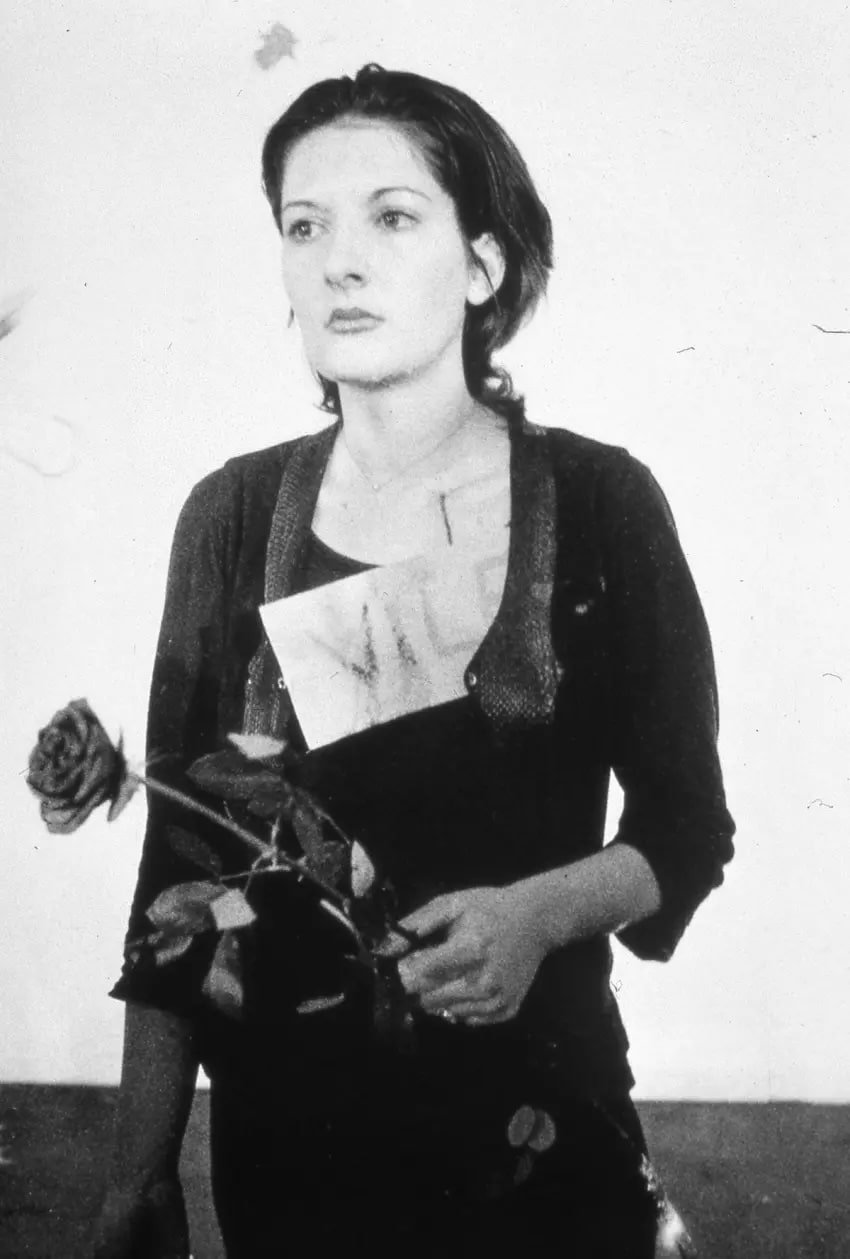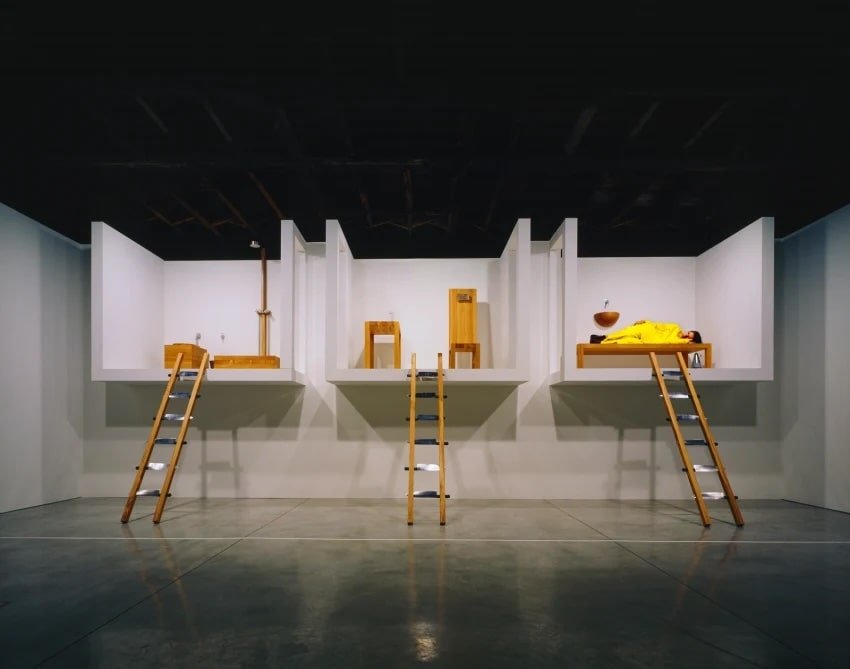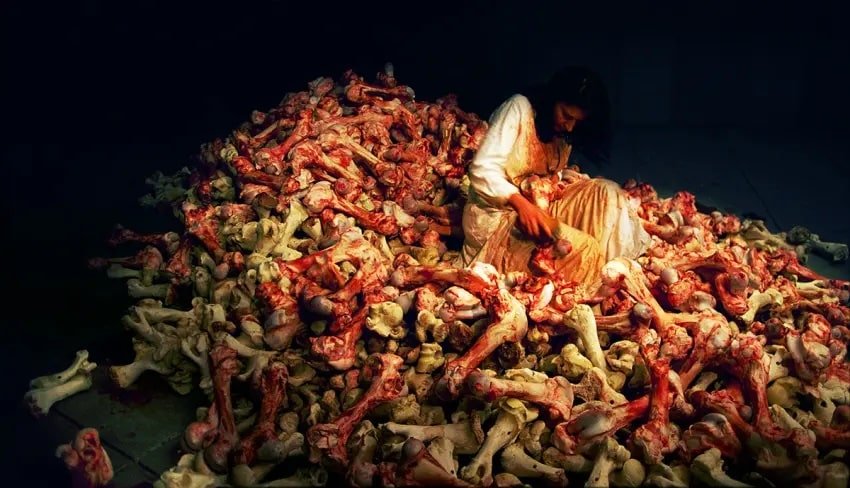Marina Abramović: A Fusion of Resilience and Vulnerability
Marina Abramović's immersive exhibition at the Royal Academy of Arts in London is a captivating exploration of endurance, vulnerability, and the enduring allure of performance art. With a career spanning over five decades, Abramović has consistently pushed the boundaries of her art, testing the limits of her body and the emotional responses of her audience.
READ MORE
Central Asia's Rising Stars: Contemporary Artists to Watch in 2024
Why Invest in Contemporary Kazakhstan Art?
Marina Abramović Exhibition at the Royal Academy of Arts
Marina Abramović. The Current (detail), 2017. Video. Performance for video, 1 hour, Brazil. Courtesy of the Marina Abramović Archives. © Marina Abramović
One is immediately struck by the audacity of Abramović's art. Her performances are unrelenting, often teetering on the brink of physical and mental extremes. In her earlier piece, "Rhythm 0" (1974), she invited the audience to use objects on her body as they saw fit. What began innocently soon took a dark turn as participants subjected her to physical harm. This starkly reminds us of the ease with which we can dehumanise others when given the chance, shedding light on the complexities of human ethics and group dynamics.
Marina Abramović
Rhythm 0, 1974
Performance; 6 hours. Studio Morra, Naples. Courtesy of the Marina Abramović Archives © Marina Abramović. Photo: Donatelli Sbarra
One of the most creatively prolific periods of Abramović's career was her collaboration with the German artist Ulay. The exhibition's central space is filled with recordings of their performances, where they slapped each other's faces, breathed as one, and engaged in wordless, seemingly endless screaming matches. Another gallery documents their final collaboration, "The Lovers, The Great Wall Walk" (1988), where they spent three months hiking from opposite ends of the Great Wall of China. The pair's public parting during this work, as Ulay revealed he had impregnated his translator en route, marked the end of their artistic collaboration and tumultuous romance. Break-ups are usually shabby and private affairs, but this public separation had the epic grandeur of Napoleon's retreat from Moscow. Demonstrations of heroic dignity are integral to Abramović's persona, particularly evident in the reenactment of their "Imponderabilia" (1977) performance at the RA. Here, two impassive young performers stand in for Abramović and Ulay, their naked bodies facing each other in a narrow doorway. The original work forced anyone crossing this threshold into an uncomfortably close encounter with the artists' genitals. However, the RA has provided an alternative route that avoids this intimate crossing. It's a reflection of our more sensitised times that most gallery-goers opt for this alternative, although it's possible that such performances are less compelling without Abramović's charisma, star power, and almost tangible aura of physical and mental resilience. Over her illustrious career, she has portrayed herself as a figure transcending the boundaries of human experience on behalf of her audience, embodying part fierce warrior queen and part suffering Christ. This has fostered a unique personal identification between the artist and her audience, cultivating an almost cult-like following.
Marina Abramović. The House with the Ocean View, 2002. Performance; 12 days. Sean Kelly Gallery, New York. Courtesy of the Marina Abramović Archives © Marina Abramović. Photo: Attilio Maranzano
Yet, not all aspects of Abramović's practice resonate equally with everyone. Some may find her performances overly solemn and devoid of humour, neglecting the inherent comedic aspects of human existence. Her later sculptural works, such as "Portal" (2022), may come across as esoteric and self-indulgent.
One room in the exhibition recreates the intensity of Abramović's 1997 performance, "Balkan Baroque," where she attempted to clean 1,500 bloodied cattle bones in response to the ethnic conflicts following the breakup of Yugoslavia in 1992. Unfortunately, the impact falls short with a relatively modest pile of replica polyurethane bones, lacking the visceral punch of the original.
Marina Abramović. Balkan Baroque, 1997. Performance; XLVII Venice Biennale, June 1997; 4 days. Courtesy of the Marina Abramović Archives © Marina Abramović
Nevertheless, Abramović's retrospective at the Royal Academy of Arts is a testament to her pioneering spirit and enduring influence on the world of performance art. Her ability to challenge the boundaries of the human experience and provoke visceral reactions from her audience is a rare and awe-inspiring quality. For those new to Abramović's work, this exhibition provides a powerful introduction to an artist who has revolutionised performance art.
In the end, Marina Abramović remains an elemental figure, part fierce warrior queen and part suffering Christ. Her legacy is undeniable, and her art continues to challenge and inspire audiences worldwide. This exhibition, despite its minor shortcomings, captures the essence of her groundbreaking career, offering a glimpse into the enduring power of performance art.
Exhibition Details:
Venue: Royal Academy of Arts, London
Dates: Until January 1, 2024
Marina Abramović’s Institute Takeover: Southbank Centre, London, from October 4–8, 2023
FAQ (Frequently Asked Questions)
Who is Marina Abramović?
Marina Abramović is a renowned Serbian-born performance artist known for her pioneering and boundary-pushing work in the field of performance art. She has been active in the art world for over five decades and is celebrated for her endurance-based performances.
What is performance art?
Performance art is a genre of art in which the artist uses their body and actions as the medium of expression. It often involves live performances that challenge traditional forms of visual art, such as painting and sculpture.
What are some of Marina Abramović's most famous works?
Some of Marina Abramović's most famous works include "The Artist is Present" (2010), "Rhythm 0" (1974), and her collaborative works with Ulay, such as "The Lovers, The Great Wall Walk" (1988).
What is "The Artist is Present"?
"The Artist is Present" is one of Marina Abramović's most well-known works, performed at the Museum of Modern Art (MoMA) in 2010. It involved Abramović sitting silently at a table while making eye contact with museum visitors who took turns sitting across from her.
Why is Marina Abramović's work significant?
Marina Abramović is considered a pioneer in performance art. Her work challenges the boundaries of the body, endurance, and human connection. She has played a pivotal role in shaping the contemporary art landscape.
Has Marina Abramović won any awards for her work?
Yes, Marina Abramović has received numerous awards and honours throughout her career, including the Golden Lion for Best Artist at the Venice Biennale in 1997.
What is the Marina Abramović Institute (MAI)?
The Marina Abramović Institute is an organisation founded by the artist to support the presentation and preservation of performance art. It seeks to provide resources and education for future generations of performance artists.
Is Marina Abramović still active in the art world?
Yes, Marina Abramović continues to be active in the art world. While she has faced health challenges, her work remains influential, and her retrospective exhibitions and projects continue to engage audiences.
What is the best way to appreciate Marina Abramović's art?
To appreciate Marina Abramović's art, approach it with an open mind and a willingness to engage with the emotions and ideas she explores. Her work often demands patience and contemplation to fully grasp its significance.
This post reflects our views only. We accept no liability for its content. No legal action can be taken against us based on this information. Use at your own risk.





